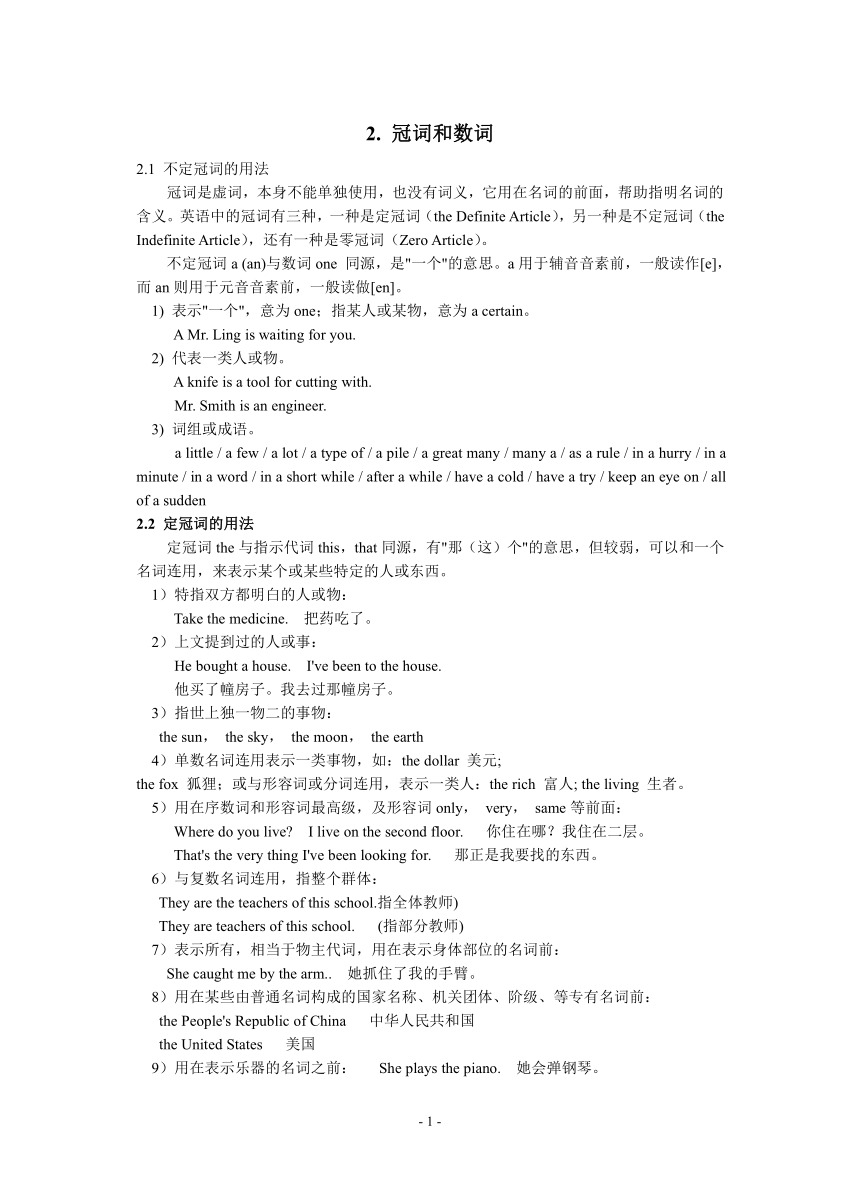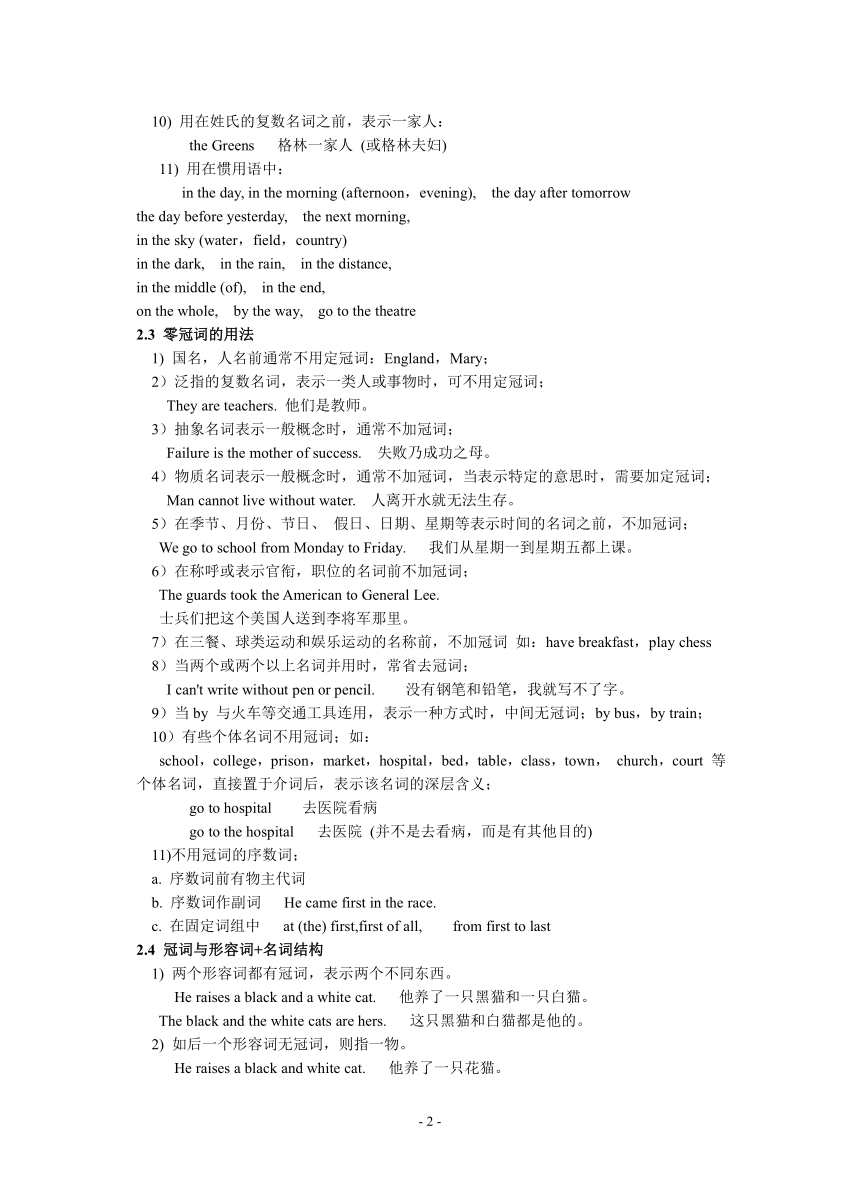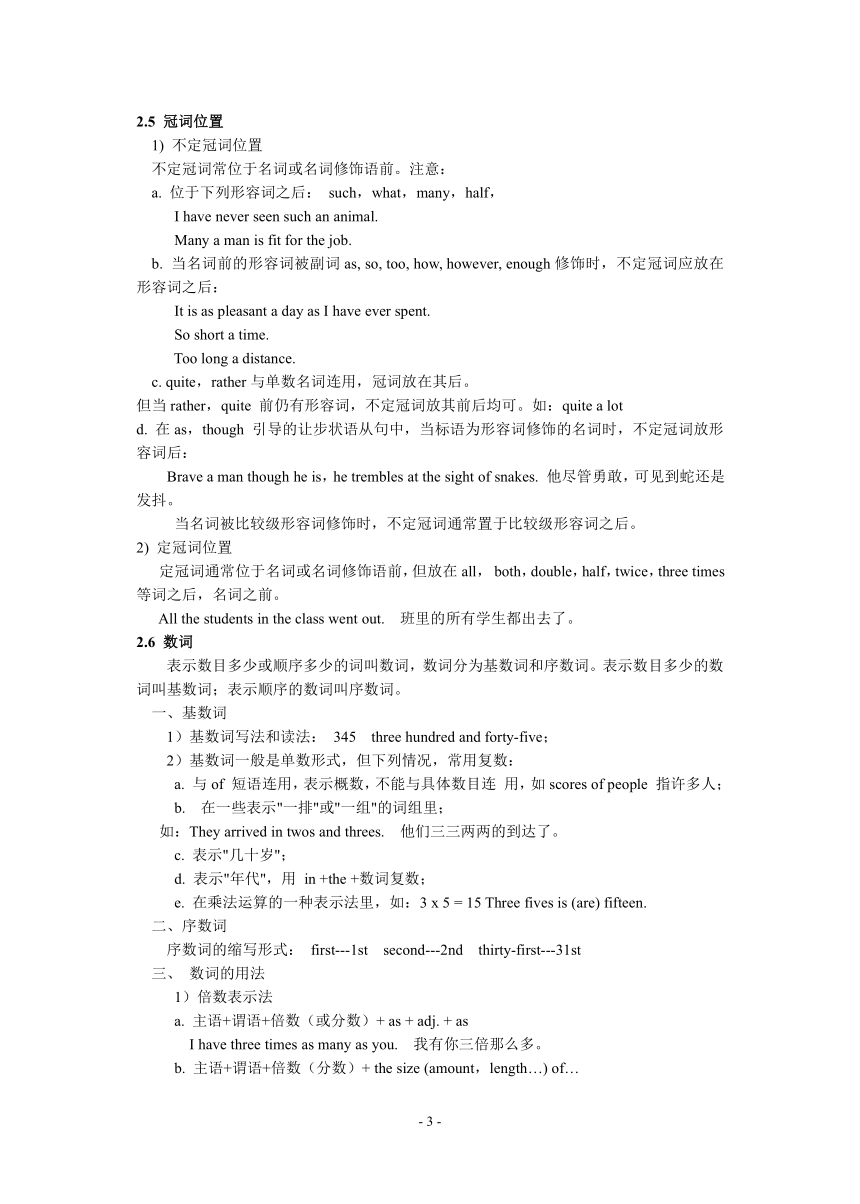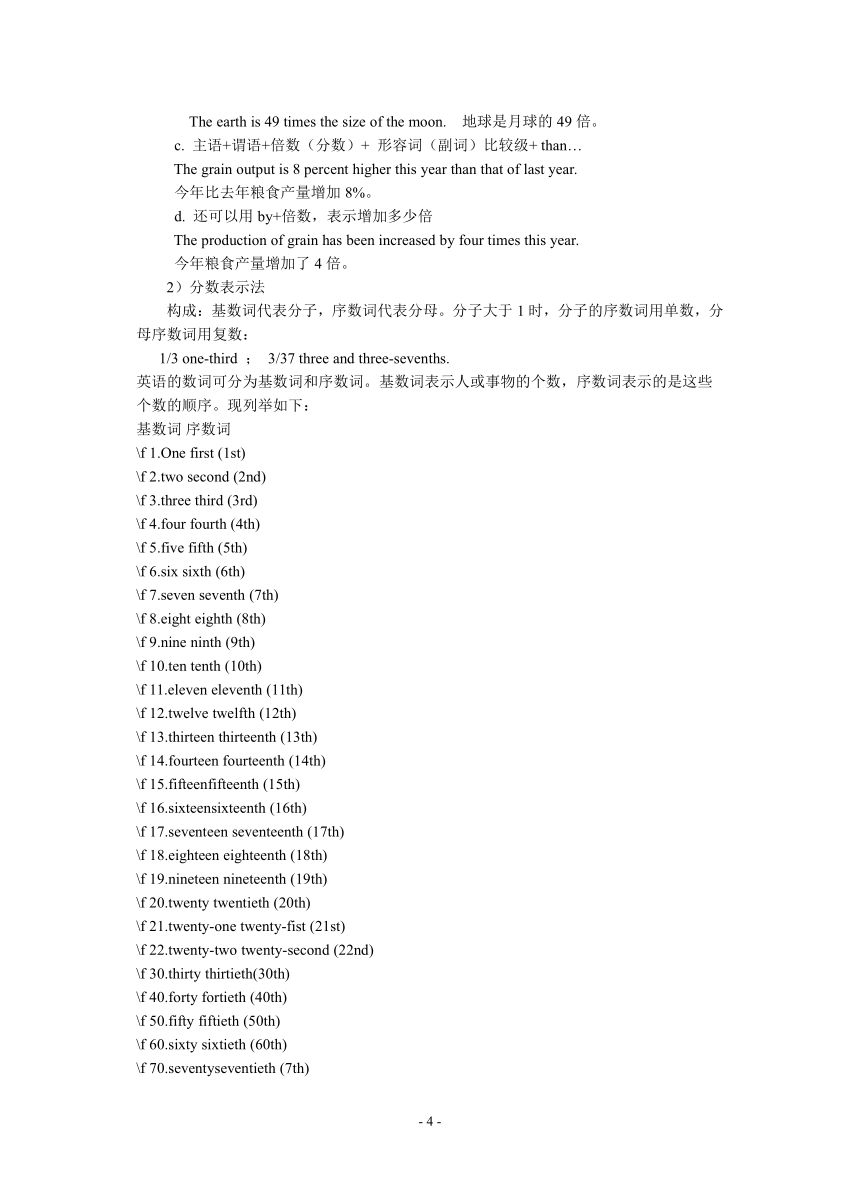2. 冠词和数词[上学期]
图片预览




文档简介
2. 冠词和数词
2.1 不定冠词的用法
冠词是虚词,本身不能单独使用,也没有词义,它用在名词的前面,帮助指明名词的含义。英语中的冠词有三种,一种是定冠词(the Definite Article),另一种是不定冠词(the Indefinite Article),还有一种是零冠词(Zero Article)。
不定冠词a (an)与数词one 同源,是"一个"的意思。a用于辅音音素前,一般读作[e],而an则用于元音音素前,一般读做[en]。
1) 表示"一个",意为one;指某人或某物,意为a certain。
A Mr. Ling is waiting for you.
2) 代表一类人或物。
A knife is a tool for cutting with.
Mr. Smith is an engineer.
3) 词组或成语。
a little / a few / a lot / a type of / a pile / a great many / many a / as a rule / in a hurry / in a minute / in a word / in a short while / after a while / have a cold / have a try / keep an eye on / all of a sudden
2.2 定冠词的用法
定冠词the与指示代词this,that同源,有"那(这)个"的意思,但较弱,可以和一个名词连用,来表示某个或某些特定的人或东西。
1)特指双方都明白的人或物:
Take the medicine. 把药吃了。
2)上文提到过的人或事:
He bought a house. I've been to the house.
他买了幢房子。我去过那幢房子。
3)指世上独一物二的事物:
the sun, the sky, the moon, the earth
4)单数名词连用表示一类事物,如:the dollar 美元;
the fox 狐狸;或与形容词或分词连用,表示一类人:the rich 富人; the living 生者。
5)用在序数词和形容词最高级,及形容词only, very, same等前面:
Where do you live I live on the second floor. 你住在哪?我住在二层。
That's the very thing I've been looking for. 那正是我要找的东西。
6)与复数名词连用,指整个群体:
They are the teachers of this school.指全体教师)
They are teachers of this school. (指部分教师)
7)表示所有,相当于物主代词,用在表示身体部位的名词前:
She caught me by the arm.. 她抓住了我的手臂。
8)用在某些由普通名词构成的国家名称、机关团体、阶级、等专有名词前:
the People's Republic of China 中华人民共和国
the United States 美国
9)用在表示乐器的名词之前: She plays the piano. 她会弹钢琴。
10) 用在姓氏的复数名词之前,表示一家人:
the Greens 格林一家人 (或格林夫妇)
11) 用在惯用语中:
in the day, in the morning (afternoon,evening), the day after tomorrow
the day before yesterday, the next morning,
in the sky (water,field,country)
in the dark, in the rain, in the distance,
in the middle (of), in the end,
on the whole, by the way, go to the theatre
2.3 零冠词的用法
1) 国名,人名前通常不用定冠词:England,Mary;
2)泛指的复数名词,表示一类人或事物时,可不用定冠词;
They are teachers. 他们是教师。
3)抽象名词表示一般概念时,通常不加冠词;
Failure is the mother of success. 失败乃成功之母。
4)物质名词表示一般概念时,通常不加冠词,当表示特定的意思时,需要加定冠词;
Man cannot live without water. 人离开水就无法生存。
5)在季节、月份、节日、 假日、日期、星期等表示时间的名词之前,不加冠词;
We go to school from Monday to Friday. 我们从星期一到星期五都上课。
6)在称呼或表示官衔,职位的名词前不加冠词;
The guards took the American to General Lee.
士兵们把这个美国人送到李将军那里。
7)在三餐、球类运动和娱乐运动的名称前,不加冠词 如:have breakfast,play chess
8)当两个或两个以上名词并用时,常省去冠词;
I can't write without pen or pencil. 没有钢笔和铅笔,我就写不了字。
9)当by 与火车等交通工具连用,表示一种方式时,中间无冠词;by bus,by train;
10)有些个体名词不用冠词;如:
school,college,prison,market,hospital,bed,table,class,town, church,court 等个体名词,直接置于介词后,表示该名词的深层含义;
go to hospital 去医院看病
go to the hospital 去医院 (并不是去看病,而是有其他目的)
11)不用冠词的序数词;
a. 序数词前有物主代词
b. 序数词作副词 He came first in the race.
c. 在固定词组中 at (the) first,first of all, from first to last
2.4 冠词与形容词+名词结构
1) 两个形容词都有冠词,表示两个不同东西。
He raises a black and a white cat. 他养了一只黑猫和一只白猫。
The black and the white cats are hers. 这只黑猫和白猫都是他的。
2) 如后一个形容词无冠词,则指一物。
He raises a black and white cat. 他养了一只花猫。
2.5 冠词位置
1) 不定冠词位置
不定冠词常位于名词或名词修饰语前。注意:
a. 位于下列形容词之后: such,what,many,half,
I have never seen such an animal.
Many a man is fit for the job.
b. 当名词前的形容词被副词as, so, too, how, however, enough修饰时,不定冠词应放在形容词之后:
It is as pleasant a day as I have ever spent.
So short a time.
Too long a distance.
c. quite,rather与单数名词连用,冠词放在其后。
但当rather,quite 前仍有形容词,不定冠词放其前后均可。如:quite a lot
d. 在as,though 引导的让步状语从句中,当标语为形容词修饰的名词时,不定冠词放形容词后:
Brave a man though he is,he trembles at the sight of snakes. 他尽管勇敢,可见到蛇还是发抖。
当名词被比较级形容词修饰时,不定冠词通常置于比较级形容词之后。
2) 定冠词位置
定冠词通常位于名词或名词修饰语前,但放在all, both,double,half,twice,three times等词之后,名词之前。
All the students in the class went out. 班里的所有学生都出去了。
2.6 数词
表示数目多少或顺序多少的词叫数词,数词分为基数词和序数词。表示数目多少的数词叫基数词;表示顺序的数词叫序数词。
一、基数词
1)基数词写法和读法: 345 three hundred and forty-five;
2)基数词一般是单数形式,但下列情况,常用复数:
a. 与of 短语连用,表示概数,不能与具体数目连 用,如scores of people 指许多人;
b. 在一些表示"一排"或"一组"的词组里;
如:They arrived in twos and threes. 他们三三两两的到达了。
c. 表示"几十岁";
d. 表示"年代",用 in +the +数词复数;
e. 在乘法运算的一种表示法里,如:3 x 5 = 15 Three fives is (are) fifteen.
二、序数词
序数词的缩写形式: first---1st second---2nd thirty-first---31st
三、 数词的用法
1)倍数表示法
a. 主语+谓语+倍数(或分数)+ as + adj. + as
I have three times as many as you. 我有你三倍那么多。
b. 主语+谓语+倍数(分数)+ the size (amount,length…) of…
The earth is 49 times the size of the moon. 地球是月球的49倍。
c. 主语+谓语+倍数(分数)+ 形容词(副词)比较级+ than…
The grain output is 8 percent higher this year than that of last year.
今年比去年粮食产量增加8%。
d. 还可以用by+倍数,表示增加多少倍
The production of grain has been increased by four times this year.
今年粮食产量增加了4倍。
2)分数表示法
构成:基数词代表分子,序数词代表分母。分子大于1时,分子的序数词用单数,分母序数词用复数:
1/3 one-third ; 3/37 three and three-sevenths.
英语的数词可分为基数词和序数词。基数词表示人或事物的个数,序数词表示的是这些
个数的顺序。现列举如下:
基数词 序数词
\f 1.One first (1st)
\f 2.two second (2nd)
\f 3.three third (3rd)
\f 4.four fourth (4th)
\f 5.five fifth (5th)
\f 6.six sixth (6th)
\f 7.seven seventh (7th)
\f 8.eight eighth (8th)
\f 9.nine ninth (9th)
\f 10.ten tenth (10th)
\f 11.eleven eleventh (11th)
\f 12.twelve twelfth (12th)
\f 13.thirteen thirteenth (13th)
\f 14.fourteen fourteenth (14th)
\f 15.fifteenfifteenth (15th)
\f 16.sixteensixteenth (16th)
\f 17.seventeen seventeenth (17th)
\f 18.eighteen eighteenth (18th)
\f 19.nineteen nineteenth (19th)
\f 20.twenty twentieth (20th)
\f 21.twenty-one twenty-fist (21st)
\f 22.twenty-two twenty-second (22nd)
\f 30.thirty thirtieth(30th)
\f 40.forty fortieth (40th)
\f 50.fifty fiftieth (50th)
\f 60.sixty sixtieth (60th)
\f 70.seventyseventieth (7th)
\f 80.eighty eightieth (80th)
\f 90.ninety ninetieth (90th)
\f 100.a/one hundred one-hundredth (100th)
\f 101.one hundred and one one hundred and first (101st)
\f 1000.a/one thousand one thousandth (1000th)
\f 1,000,000.a/one million one millionth (1,000,000th)
除了first, second, third以及和它们一起组成的高位序数词以外,序数词的构成方法是在
相应的基数词之后加-th,但要注意fifth, eighth, twelfth等不规则拼法。twenty, thirty等在变
为序数词时,要把y变成i, 再加-eth。
整数的表示方法
1.表示二十以上的十位数,要在个位数与十位数之间加连字符号。表示百位数,要在
百位数与十位数之间(无十位数,则在百位数和个位数之间)加and。在美国英语中,and往
往省去。如:
68 ─ sixty-eight
156 ─ one/a hundred (and) fifty-six
602 ─ six hundred (and) two
2.书写千位数以上的阿拉伯数字,从后往前每隔三位用一分节号,如:
1,000 = one/a thousand
10,000 = ten thousand
100,000 = one/a hundred thousand
1,000,000 = one/a million
在一些科技文章中,千位以上的数不使用分节号,而用一个空白字符表示分节,如:56
112 482。
3.hundred, thousand, million等词前面有具体数字或several修饰时,不加-s。如:
The magazine has two million readers.
不与数词或several连用,可以复数形式出现,表示“数以百计”、“成千上万”等。如:
Mr. Smith has donated (捐赠) hundreds of books to the school. (数以百计)
倍数的表达方法
1.用…times表示。如:
My room is three times as large as yours.
我的房间是你的三倍大小。
如果表示“是……两倍数”,一般用twice。如:
My room is twice as large as yours.
我的房间是你的两倍大小。
2.用-fold表示。如:
The value of the stock has increased two-fold since we bought it .
股票的价值已涨至我们购买时候的两倍。
3.用-%表示。如:
The collection of our school library is 200% up compared with 1998.
我们学校图书馆藏书量与1998年相比增长了一倍.
4.用double(翻一番),triple(三倍于),again等词表示倍数。如:
This coat cost me as much again as the coat I have just bought.
这件外套和我刚买的那件外套的价格一样。
分数、小数和百分数表示法
1.分数的分子以基数词表示,分母以序数词表示,当分子大于1时,序数词要用复数,
其写法与读法如下:
1/2 — a/one half
1/3 — a/one third
1/4 — a/one fourth; a/one quarter
2/5 — two fifths
2.小数是以基数词加小数点表示,小数点前面的数按基数词的规则读,小数点后面的数
按个位基数词依次读出,如:
0.5 — zero point five
0.006 — zero point zero zero six
0.257 — zero point two five seven
148.06 — a/one hundred and forty-eight point zero six
其中zero可替换为naught或读作oh。
3.百分数是由基数词或小数加百分号组成,百分号(%)读作per cent,如:
0.6% — zero point six per cent
5% — five per cent
100% — one hundred per cent
12.34% — twelve point three four per cent
时间的表示法
1.十二小时计时制
使用十二小时计时制,为了避免午前、午后时刻的混淆,有时要在时刻后面加a.m. /am
或p.m. /pm以示区别。如:10:11 a.m.、 6:20 p.m.。
2.二十四小时计时制
用于军事或国际时刻的二十四小时制,书写时用四位数字。“时”和“分”之间可用“:”,
也可省略。如:0000(零时)、1300(十三时)、18:30(十八时三十分)。
年、月、日的表示法
1.年份的表示法
年份通常用阿拉伯数字表示,用基数词读。公元前用B.C.表示,公元用A.D.表示,读
其字母音。A.D.
一般用于公元1年到公元999年之间的年份。如:
公元前502年写作502 B.C.
公元429年写作429 A.D.
公元1000年写作1000。
2.年代表示法
年代用年份的阿拉伯数字加-’s或-s表示。如:
十七世纪二十年代写作1620’s或1620s。
初期、中期、末期分别用early,mid-和late表示。如:
三十年代初期写作the early thirties。
三十年代中期写作the mid-thirties。
三十年代末期写作the late thirties。
二十世纪五十年代初期写作the early 1950’s;
中期写作the mid-1950’s;
末期写作the late 1950’s。
3.月、日的表示法
表示月、日既可以先写“月”再写“日”,也可先写“日”再写“月”。如:
9月1日写作September 1,读作September the first;或1 September,读作the first of
September。
表示年、月、日,要将年份放在最后,用逗号和月、日隔开,如1998年7月1日写作
July 1, 1998或1 July, 1998。
在非正式文体中,年、月、日可以全用数字表示。如:
1996年6月10日写作6,10,1996或10,6,1996。为避免误解,宜将月份拼出。
不定数目的表示法
1.“大约”的表示法
(1) about, approximately, around, more or less, roughly, some等词+数词,或数词+more or
less, or so, or thereabouts等词。如:
about / some 1,000 books
2,000 seats more or less
approximately 86 miles
sixty or so pages / sixty pages or so / sixty pages or thereabouts
somewhere也可表示“大约”,如somewhere about 300 people。
(2) 基数词或阿拉伯数字末尾 + -ish。如:
I’ll come (at) tenish tomorrow morning. (十点左右)
She is 40ish. (五十岁左右)
(3) 十位数 + -s。如:
He is in his teens.
She is in her forties.
2.“多于……”、“大于……”表示法
(1) above, more than, over等 + 数词。如:
above 90 Yuan
students over 45
(2) 数词 + odd。如:
20-odd chairs
3.“少于……”、“不到……”表示法
almost, below, less than, under等 + 数词。如:
almost ten years old
less than a minute
under two hours
数词的特殊用法
1.a + 序数词(再一……,又一……)和the + 序数词(第……)
I’ll see the movie a second time.(再看一次)
This is the second time I have seen the film. (第二次)
2. 具有夸张含义的成语中的数词并不表示具体的数。如:
The glass broke into a hundred pieces.(摔得粉碎)
Once bitten, twice shy.(一次被咬,下次胆小)
A thousand thanks to you.(万分感谢) 形容词是指用来修饰名词的词。
形容词最典型的位置是位于限定词与名词之间,在这种位置上的形容词被称为定语,如:
all those three old trees.
所有那三棵老树。
形容词的第二个重要位置是在be或其它系动词之后,作主语补语用,如:
The door is close.
门是关的。
作主语补语的形容词还可以作宾主补语,如:
He pushed the door open.
他把门推开了。
形容词除了作定语、主语补语和宾语补语外,还可以作状语,如:
dark brown hair 深褐色的头发
icy cold water 冰冷的水
此外,某些形容词在某些条件下具有名词的句法作用,作主语或宾语。许多形容词没有
形式特征,但有些形容词具有形式特征,形容词的典型词尾包括:
-able / -ible, 如:comfortable, contemptible
-ish / -like, 如:childish, childlike
-ful / -less, 如:powerful, powerless
-ous, 如:delicious, anxious
-y, 如:pretty, dirty
PAGE
- 8 -
2.1 不定冠词的用法
冠词是虚词,本身不能单独使用,也没有词义,它用在名词的前面,帮助指明名词的含义。英语中的冠词有三种,一种是定冠词(the Definite Article),另一种是不定冠词(the Indefinite Article),还有一种是零冠词(Zero Article)。
不定冠词a (an)与数词one 同源,是"一个"的意思。a用于辅音音素前,一般读作[e],而an则用于元音音素前,一般读做[en]。
1) 表示"一个",意为one;指某人或某物,意为a certain。
A Mr. Ling is waiting for you.
2) 代表一类人或物。
A knife is a tool for cutting with.
Mr. Smith is an engineer.
3) 词组或成语。
a little / a few / a lot / a type of / a pile / a great many / many a / as a rule / in a hurry / in a minute / in a word / in a short while / after a while / have a cold / have a try / keep an eye on / all of a sudden
2.2 定冠词的用法
定冠词the与指示代词this,that同源,有"那(这)个"的意思,但较弱,可以和一个名词连用,来表示某个或某些特定的人或东西。
1)特指双方都明白的人或物:
Take the medicine. 把药吃了。
2)上文提到过的人或事:
He bought a house. I've been to the house.
他买了幢房子。我去过那幢房子。
3)指世上独一物二的事物:
the sun, the sky, the moon, the earth
4)单数名词连用表示一类事物,如:the dollar 美元;
the fox 狐狸;或与形容词或分词连用,表示一类人:the rich 富人; the living 生者。
5)用在序数词和形容词最高级,及形容词only, very, same等前面:
Where do you live I live on the second floor. 你住在哪?我住在二层。
That's the very thing I've been looking for. 那正是我要找的东西。
6)与复数名词连用,指整个群体:
They are the teachers of this school.指全体教师)
They are teachers of this school. (指部分教师)
7)表示所有,相当于物主代词,用在表示身体部位的名词前:
She caught me by the arm.. 她抓住了我的手臂。
8)用在某些由普通名词构成的国家名称、机关团体、阶级、等专有名词前:
the People's Republic of China 中华人民共和国
the United States 美国
9)用在表示乐器的名词之前: She plays the piano. 她会弹钢琴。
10) 用在姓氏的复数名词之前,表示一家人:
the Greens 格林一家人 (或格林夫妇)
11) 用在惯用语中:
in the day, in the morning (afternoon,evening), the day after tomorrow
the day before yesterday, the next morning,
in the sky (water,field,country)
in the dark, in the rain, in the distance,
in the middle (of), in the end,
on the whole, by the way, go to the theatre
2.3 零冠词的用法
1) 国名,人名前通常不用定冠词:England,Mary;
2)泛指的复数名词,表示一类人或事物时,可不用定冠词;
They are teachers. 他们是教师。
3)抽象名词表示一般概念时,通常不加冠词;
Failure is the mother of success. 失败乃成功之母。
4)物质名词表示一般概念时,通常不加冠词,当表示特定的意思时,需要加定冠词;
Man cannot live without water. 人离开水就无法生存。
5)在季节、月份、节日、 假日、日期、星期等表示时间的名词之前,不加冠词;
We go to school from Monday to Friday. 我们从星期一到星期五都上课。
6)在称呼或表示官衔,职位的名词前不加冠词;
The guards took the American to General Lee.
士兵们把这个美国人送到李将军那里。
7)在三餐、球类运动和娱乐运动的名称前,不加冠词 如:have breakfast,play chess
8)当两个或两个以上名词并用时,常省去冠词;
I can't write without pen or pencil. 没有钢笔和铅笔,我就写不了字。
9)当by 与火车等交通工具连用,表示一种方式时,中间无冠词;by bus,by train;
10)有些个体名词不用冠词;如:
school,college,prison,market,hospital,bed,table,class,town, church,court 等个体名词,直接置于介词后,表示该名词的深层含义;
go to hospital 去医院看病
go to the hospital 去医院 (并不是去看病,而是有其他目的)
11)不用冠词的序数词;
a. 序数词前有物主代词
b. 序数词作副词 He came first in the race.
c. 在固定词组中 at (the) first,first of all, from first to last
2.4 冠词与形容词+名词结构
1) 两个形容词都有冠词,表示两个不同东西。
He raises a black and a white cat. 他养了一只黑猫和一只白猫。
The black and the white cats are hers. 这只黑猫和白猫都是他的。
2) 如后一个形容词无冠词,则指一物。
He raises a black and white cat. 他养了一只花猫。
2.5 冠词位置
1) 不定冠词位置
不定冠词常位于名词或名词修饰语前。注意:
a. 位于下列形容词之后: such,what,many,half,
I have never seen such an animal.
Many a man is fit for the job.
b. 当名词前的形容词被副词as, so, too, how, however, enough修饰时,不定冠词应放在形容词之后:
It is as pleasant a day as I have ever spent.
So short a time.
Too long a distance.
c. quite,rather与单数名词连用,冠词放在其后。
但当rather,quite 前仍有形容词,不定冠词放其前后均可。如:quite a lot
d. 在as,though 引导的让步状语从句中,当标语为形容词修饰的名词时,不定冠词放形容词后:
Brave a man though he is,he trembles at the sight of snakes. 他尽管勇敢,可见到蛇还是发抖。
当名词被比较级形容词修饰时,不定冠词通常置于比较级形容词之后。
2) 定冠词位置
定冠词通常位于名词或名词修饰语前,但放在all, both,double,half,twice,three times等词之后,名词之前。
All the students in the class went out. 班里的所有学生都出去了。
2.6 数词
表示数目多少或顺序多少的词叫数词,数词分为基数词和序数词。表示数目多少的数词叫基数词;表示顺序的数词叫序数词。
一、基数词
1)基数词写法和读法: 345 three hundred and forty-five;
2)基数词一般是单数形式,但下列情况,常用复数:
a. 与of 短语连用,表示概数,不能与具体数目连 用,如scores of people 指许多人;
b. 在一些表示"一排"或"一组"的词组里;
如:They arrived in twos and threes. 他们三三两两的到达了。
c. 表示"几十岁";
d. 表示"年代",用 in +the +数词复数;
e. 在乘法运算的一种表示法里,如:3 x 5 = 15 Three fives is (are) fifteen.
二、序数词
序数词的缩写形式: first---1st second---2nd thirty-first---31st
三、 数词的用法
1)倍数表示法
a. 主语+谓语+倍数(或分数)+ as + adj. + as
I have three times as many as you. 我有你三倍那么多。
b. 主语+谓语+倍数(分数)+ the size (amount,length…) of…
The earth is 49 times the size of the moon. 地球是月球的49倍。
c. 主语+谓语+倍数(分数)+ 形容词(副词)比较级+ than…
The grain output is 8 percent higher this year than that of last year.
今年比去年粮食产量增加8%。
d. 还可以用by+倍数,表示增加多少倍
The production of grain has been increased by four times this year.
今年粮食产量增加了4倍。
2)分数表示法
构成:基数词代表分子,序数词代表分母。分子大于1时,分子的序数词用单数,分母序数词用复数:
1/3 one-third ; 3/37 three and three-sevenths.
英语的数词可分为基数词和序数词。基数词表示人或事物的个数,序数词表示的是这些
个数的顺序。现列举如下:
基数词 序数词
\f 1.One first (1st)
\f 2.two second (2nd)
\f 3.three third (3rd)
\f 4.four fourth (4th)
\f 5.five fifth (5th)
\f 6.six sixth (6th)
\f 7.seven seventh (7th)
\f 8.eight eighth (8th)
\f 9.nine ninth (9th)
\f 10.ten tenth (10th)
\f 11.eleven eleventh (11th)
\f 12.twelve twelfth (12th)
\f 13.thirteen thirteenth (13th)
\f 14.fourteen fourteenth (14th)
\f 15.fifteenfifteenth (15th)
\f 16.sixteensixteenth (16th)
\f 17.seventeen seventeenth (17th)
\f 18.eighteen eighteenth (18th)
\f 19.nineteen nineteenth (19th)
\f 20.twenty twentieth (20th)
\f 21.twenty-one twenty-fist (21st)
\f 22.twenty-two twenty-second (22nd)
\f 30.thirty thirtieth(30th)
\f 40.forty fortieth (40th)
\f 50.fifty fiftieth (50th)
\f 60.sixty sixtieth (60th)
\f 70.seventyseventieth (7th)
\f 80.eighty eightieth (80th)
\f 90.ninety ninetieth (90th)
\f 100.a/one hundred one-hundredth (100th)
\f 101.one hundred and one one hundred and first (101st)
\f 1000.a/one thousand one thousandth (1000th)
\f 1,000,000.a/one million one millionth (1,000,000th)
除了first, second, third以及和它们一起组成的高位序数词以外,序数词的构成方法是在
相应的基数词之后加-th,但要注意fifth, eighth, twelfth等不规则拼法。twenty, thirty等在变
为序数词时,要把y变成i, 再加-eth。
整数的表示方法
1.表示二十以上的十位数,要在个位数与十位数之间加连字符号。表示百位数,要在
百位数与十位数之间(无十位数,则在百位数和个位数之间)加and。在美国英语中,and往
往省去。如:
68 ─ sixty-eight
156 ─ one/a hundred (and) fifty-six
602 ─ six hundred (and) two
2.书写千位数以上的阿拉伯数字,从后往前每隔三位用一分节号,如:
1,000 = one/a thousand
10,000 = ten thousand
100,000 = one/a hundred thousand
1,000,000 = one/a million
在一些科技文章中,千位以上的数不使用分节号,而用一个空白字符表示分节,如:56
112 482。
3.hundred, thousand, million等词前面有具体数字或several修饰时,不加-s。如:
The magazine has two million readers.
不与数词或several连用,可以复数形式出现,表示“数以百计”、“成千上万”等。如:
Mr. Smith has donated (捐赠) hundreds of books to the school. (数以百计)
倍数的表达方法
1.用…times表示。如:
My room is three times as large as yours.
我的房间是你的三倍大小。
如果表示“是……两倍数”,一般用twice。如:
My room is twice as large as yours.
我的房间是你的两倍大小。
2.用-fold表示。如:
The value of the stock has increased two-fold since we bought it .
股票的价值已涨至我们购买时候的两倍。
3.用-%表示。如:
The collection of our school library is 200% up compared with 1998.
我们学校图书馆藏书量与1998年相比增长了一倍.
4.用double(翻一番),triple(三倍于),again等词表示倍数。如:
This coat cost me as much again as the coat I have just bought.
这件外套和我刚买的那件外套的价格一样。
分数、小数和百分数表示法
1.分数的分子以基数词表示,分母以序数词表示,当分子大于1时,序数词要用复数,
其写法与读法如下:
1/2 — a/one half
1/3 — a/one third
1/4 — a/one fourth; a/one quarter
2/5 — two fifths
2.小数是以基数词加小数点表示,小数点前面的数按基数词的规则读,小数点后面的数
按个位基数词依次读出,如:
0.5 — zero point five
0.006 — zero point zero zero six
0.257 — zero point two five seven
148.06 — a/one hundred and forty-eight point zero six
其中zero可替换为naught或读作oh。
3.百分数是由基数词或小数加百分号组成,百分号(%)读作per cent,如:
0.6% — zero point six per cent
5% — five per cent
100% — one hundred per cent
12.34% — twelve point three four per cent
时间的表示法
1.十二小时计时制
使用十二小时计时制,为了避免午前、午后时刻的混淆,有时要在时刻后面加a.m. /am
或p.m. /pm以示区别。如:10:11 a.m.、 6:20 p.m.。
2.二十四小时计时制
用于军事或国际时刻的二十四小时制,书写时用四位数字。“时”和“分”之间可用“:”,
也可省略。如:0000(零时)、1300(十三时)、18:30(十八时三十分)。
年、月、日的表示法
1.年份的表示法
年份通常用阿拉伯数字表示,用基数词读。公元前用B.C.表示,公元用A.D.表示,读
其字母音。A.D.
一般用于公元1年到公元999年之间的年份。如:
公元前502年写作502 B.C.
公元429年写作429 A.D.
公元1000年写作1000。
2.年代表示法
年代用年份的阿拉伯数字加-’s或-s表示。如:
十七世纪二十年代写作1620’s或1620s。
初期、中期、末期分别用early,mid-和late表示。如:
三十年代初期写作the early thirties。
三十年代中期写作the mid-thirties。
三十年代末期写作the late thirties。
二十世纪五十年代初期写作the early 1950’s;
中期写作the mid-1950’s;
末期写作the late 1950’s。
3.月、日的表示法
表示月、日既可以先写“月”再写“日”,也可先写“日”再写“月”。如:
9月1日写作September 1,读作September the first;或1 September,读作the first of
September。
表示年、月、日,要将年份放在最后,用逗号和月、日隔开,如1998年7月1日写作
July 1, 1998或1 July, 1998。
在非正式文体中,年、月、日可以全用数字表示。如:
1996年6月10日写作6,10,1996或10,6,1996。为避免误解,宜将月份拼出。
不定数目的表示法
1.“大约”的表示法
(1) about, approximately, around, more or less, roughly, some等词+数词,或数词+more or
less, or so, or thereabouts等词。如:
about / some 1,000 books
2,000 seats more or less
approximately 86 miles
sixty or so pages / sixty pages or so / sixty pages or thereabouts
somewhere也可表示“大约”,如somewhere about 300 people。
(2) 基数词或阿拉伯数字末尾 + -ish。如:
I’ll come (at) tenish tomorrow morning. (十点左右)
She is 40ish. (五十岁左右)
(3) 十位数 + -s。如:
He is in his teens.
She is in her forties.
2.“多于……”、“大于……”表示法
(1) above, more than, over等 + 数词。如:
above 90 Yuan
students over 45
(2) 数词 + odd。如:
20-odd chairs
3.“少于……”、“不到……”表示法
almost, below, less than, under等 + 数词。如:
almost ten years old
less than a minute
under two hours
数词的特殊用法
1.a + 序数词(再一……,又一……)和the + 序数词(第……)
I’ll see the movie a second time.(再看一次)
This is the second time I have seen the film. (第二次)
2. 具有夸张含义的成语中的数词并不表示具体的数。如:
The glass broke into a hundred pieces.(摔得粉碎)
Once bitten, twice shy.(一次被咬,下次胆小)
A thousand thanks to you.(万分感谢) 形容词是指用来修饰名词的词。
形容词最典型的位置是位于限定词与名词之间,在这种位置上的形容词被称为定语,如:
all those three old trees.
所有那三棵老树。
形容词的第二个重要位置是在be或其它系动词之后,作主语补语用,如:
The door is close.
门是关的。
作主语补语的形容词还可以作宾主补语,如:
He pushed the door open.
他把门推开了。
形容词除了作定语、主语补语和宾语补语外,还可以作状语,如:
dark brown hair 深褐色的头发
icy cold water 冰冷的水
此外,某些形容词在某些条件下具有名词的句法作用,作主语或宾语。许多形容词没有
形式特征,但有些形容词具有形式特征,形容词的典型词尾包括:
-able / -ible, 如:comfortable, contemptible
-ish / -like, 如:childish, childlike
-ful / -less, 如:powerful, powerless
-ous, 如:delicious, anxious
-y, 如:pretty, dirty
PAGE
- 8 -
